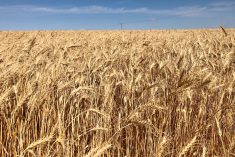CNS Canada — Larger-than-expected production, a seasonal slowdown in demand and looming Italian country-of-origin-labeling regulations all loom over the Canadian durum market, with steady to lower prices anticipated over the next few months.
Italian COOL regulations are set to come into effect in mid-February and require pasta makers in the country to segregate foreign durum, which will add costs and may cut into demand for some Canadian grain. Italy is a major buyer of Canadian durum.
Read Also

U.S. grains: Soybeans fall as rapid harvest overshadows China trade hopes
U.S. soybean futures closed lower on Friday as pressure from a fast-advancing U.S. harvest offset early-session support from hopes that upcoming U.S.-China talks could revive stalled soybean trade.
“There’s no doubt that there’s a negative perception for Canadian durum, but the quality, especially this year is phenomenal, and a lot of mills in Italy rely on Canadian durum,” said Jerry Klassen, manager of the Canadian office for Swiss-based GAP SA Grains and Products in Winnipeg.
“I think we’re still in a wait-and-see mode how this will play out,” he said, adding “Canadian durum has a fairly good reputation in Italy and Europe and general.”
Concerns over glyphosate residue on Canadian durum have hurt that reputation somewhat and were a factor in the COOL regulations.
However, “last year, it was so dry, I think you’d be hard pressed to find any farmer who used glyphosate on his durum,” said Klassen.
Glyphosate is not an optimal desiccant for durum, he added, and is rarely if ever used for that purpose.
Total Canadian durum exports to all destinations to date of 1.67 million tonnes compare with the 1.78 million tonnes exported during the same period in 2017-18, according to the latest data from the Canadian Grain Commission.
Durum prices are currently in the $270-$275 per tonne area in southern Saskatchewan, according to the latest Price and Data Quotes (PDQ) data. That compares with prices above $300 in August when the industry was concerned over drought conditions in Canada and the northern U.S.
“We had a very strong North American durum market with the drier conditions in Canada and the U.S.,” said Klassen. The market rationed demand at the time, but the yields beat expectations and left Canada with about a million more tonnes of durum than originally expected.
“Right now we’re feeling the effects of the rationing of demand in the first half of the year when we lost demand, and you never get it back,” said Klassen.
“Now the market has gone from rationing demand to a time it needs to encourage demand,” he said, adding “the only way to do that is through lower prices.”
As a result, “the market will be hard pressed to go higher,” he said, pointing to increased competition in the world and the fact that the seasonal nature of the durum market means that much of the demand is already covered for the year.
“At the same time, the farmer is selling about 100,000 tonnes a week which seems sufficient to meet the exports we do have on track,” he said. He thought farmers were probably selling a bit more durum than they would otherwise due to poor prices for other crops, especially pulses.
While farmers are selling enough durum to meet the demand, “we can’t underestimate the power of the farmer to hold back on sales,” said Klassen. Farmers grew a good-quality crop in 2017 and will be prone to storing on-farm for better prices.
Looking ahead to the new crop year, the trade is factoring in about a 15 per cent increase in durum at the expense of specialty crops, according to Klassen.
Canada seeded 5.21 million acres of durum in 2017, harvesting a 4.96 million-tonne crop.
— Phil Franz-Warkentin writes for Commodity News Service Canada, a Glacier FarmMedia company specializing in grain and commodity market reporting.














